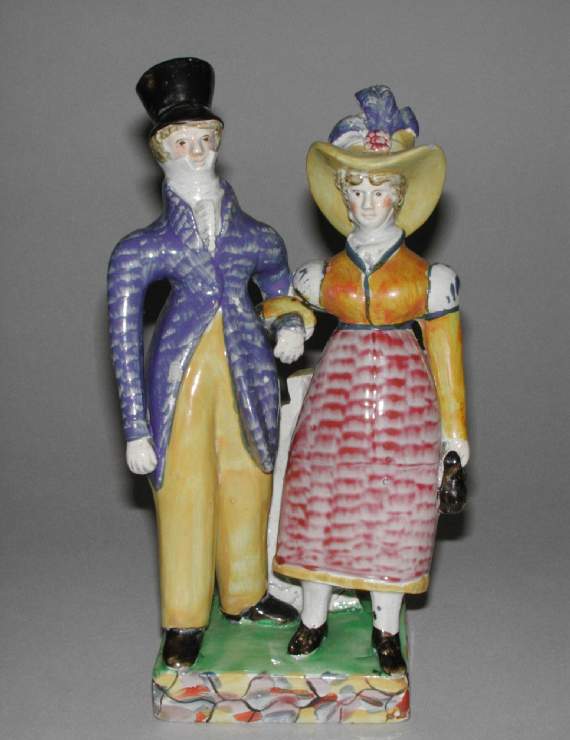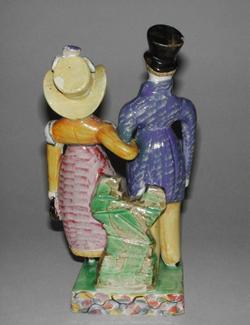Current Location: In storage
Titles
Courtship group
Maker(s)
Production:
Unidentified factory
Entities
Categories
Description
Earthenware figure group, moulded and modelled, lead-glazed and painted with polychrome enamels.
Earthenware group of a dandy and his lady walking arm in arm. The lady carries a bag in her left hand. She wears a yellow poke bonnet, a yellow blouse over a white puffed-sleeve blouse and a pink skirt. Her bonnet is very large and has a pink band with three blue feathers at the front. The gentleman wears a top hat and a frilled shirt with stock and high collar. He has a blue coat, over yellow trousers. His coat and her skirt are finely painted with a feathery effect. The rectangular base, which has stylised marble to the sides and a pale green top. At the back is a flattened tree stump. The underside is recessed and glazed.
Notes
History note: Captain Reynolds Collection, London, sold to Messrs Gill and Reigate. Bought by Mr Stoner, London, from whom purchased in 1910 by Dr J.W.L. Glaisher, Trinity College, Cambridge. Dr Glaisher paid £125 for this and fourteen other pieces, as part of a purchase of 35 figures and figure groups.
Legal notes
Dr J. W. L. Glaisher Bequest
Measurements and weight
Base Depth: 7 cm
Base Width: 8.7 cm
Height: 22 cm
Width: 12 cm
Acquisition and important dates
Method of acquisition: Bequeathed
(1928)
by
Glaisher, J. W. L., Dr
Dating
19th Century, Early
Circa
1825
-
1830
Note
Earthenware figure groups were popular from around 1810, although the earliest examples date from nearly a century before. They were produced by many small potteries and very few are marked. Classical or literary subjects might be copied from more expensive porcelain examples, but scenes from everyday life and topical events were also increasingly popular. Early figure groups are often complex, with modelled and moulded parts and applied decoration; the backs, though flat, are decorated. By c.1835, earlier methods had largely given way to three-part press-moulding which enabled faster and cheaper production for a growing market.
This fashionably dressed couple’s linked arms suggest they are courting. Such groups are particularly interesting because they show contemporary costume; they are sometimes listed as ‘Dandies’.
Components of the work
Decoration
composed of
enamels
lead-glaze
Parts
Materials used in production
White earthenware
Techniques used in production
Moulding
: Earthenware, moulded and modelled, lead glazed and painted with enamels.
Inscription or legends present
- Text: No.3207. Staffordshire courtship group of a lady and gentleman walking arm in arm. Same model as no.3208 but a much later specimen. From the Reynolds Collection, June 1910.
- Location: Underside of base
- Method of creation: Rectangular paper label handwritten in black ink
- Type: Label
References and bibliographic entries
Identification numbers
Accession number: C.971-1928
Primary reference Number: 76473
Old object number: 3207
Stable URI
Audit data
Created: Saturday 6 August 2011
Updated: Monday 29 April 2024
Last processed: Tuesday 29 July 2025
Associated departments & institutions
Owner or interested party:
The Fitzwilliam Museum
Associated department:
Applied Arts





